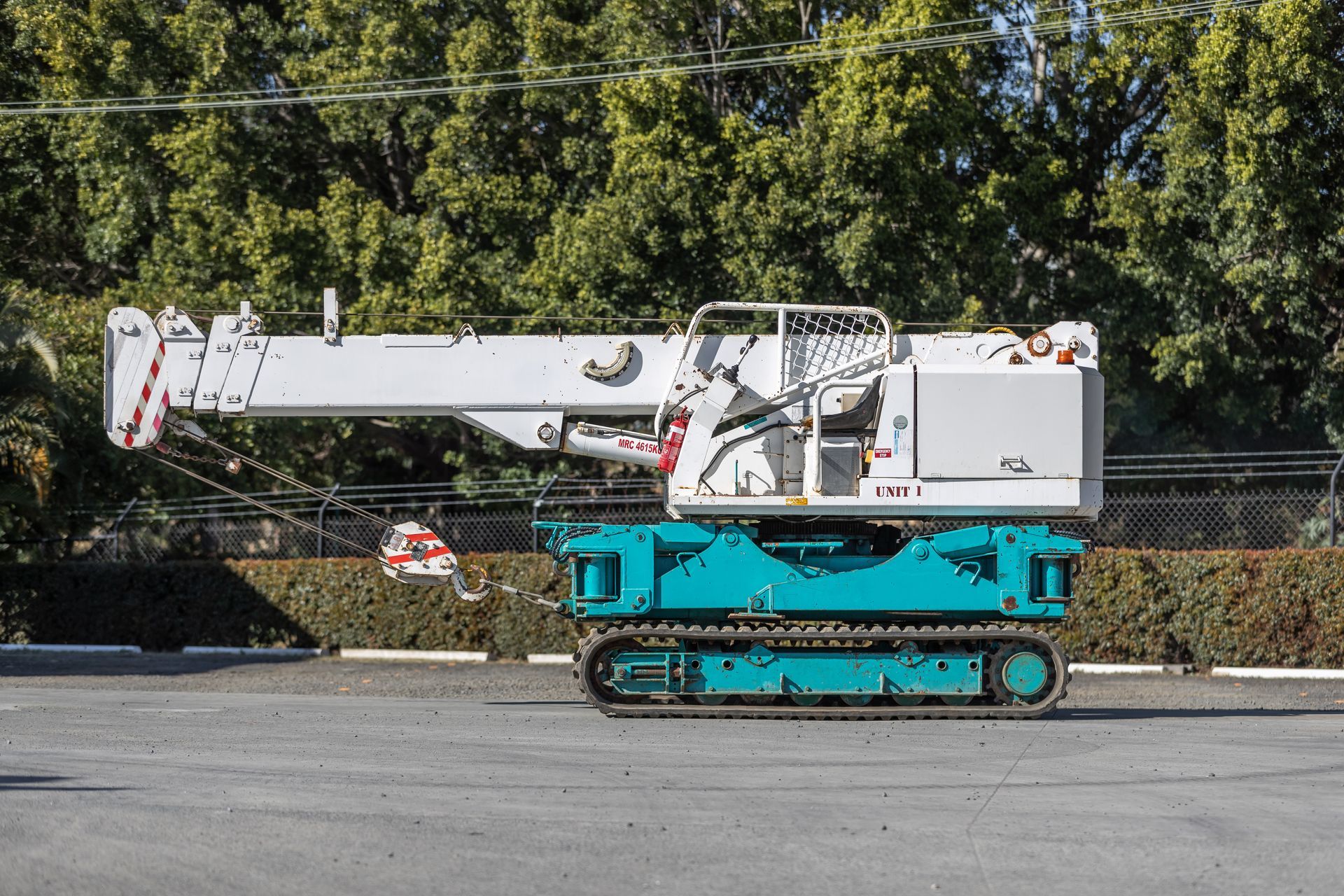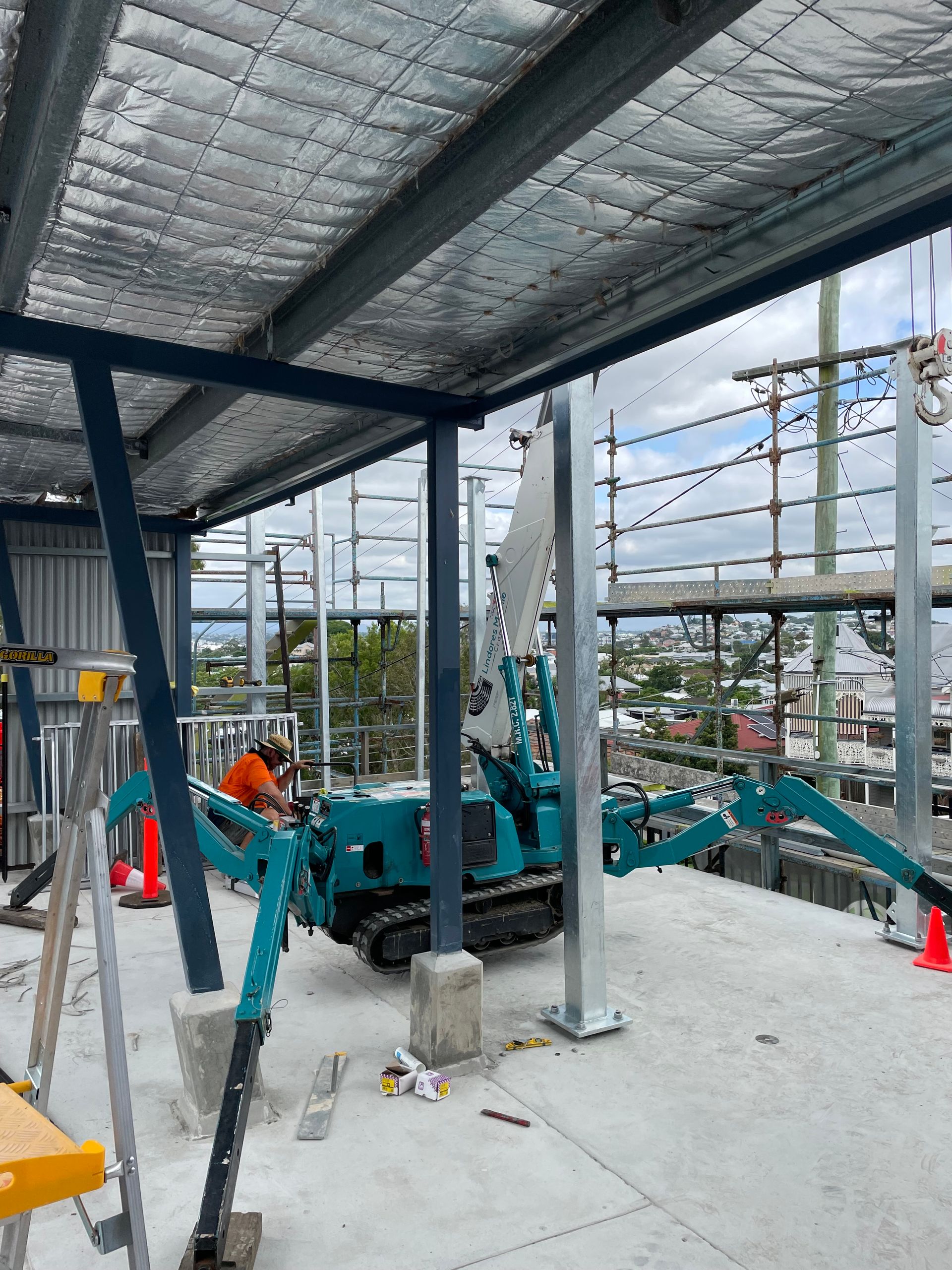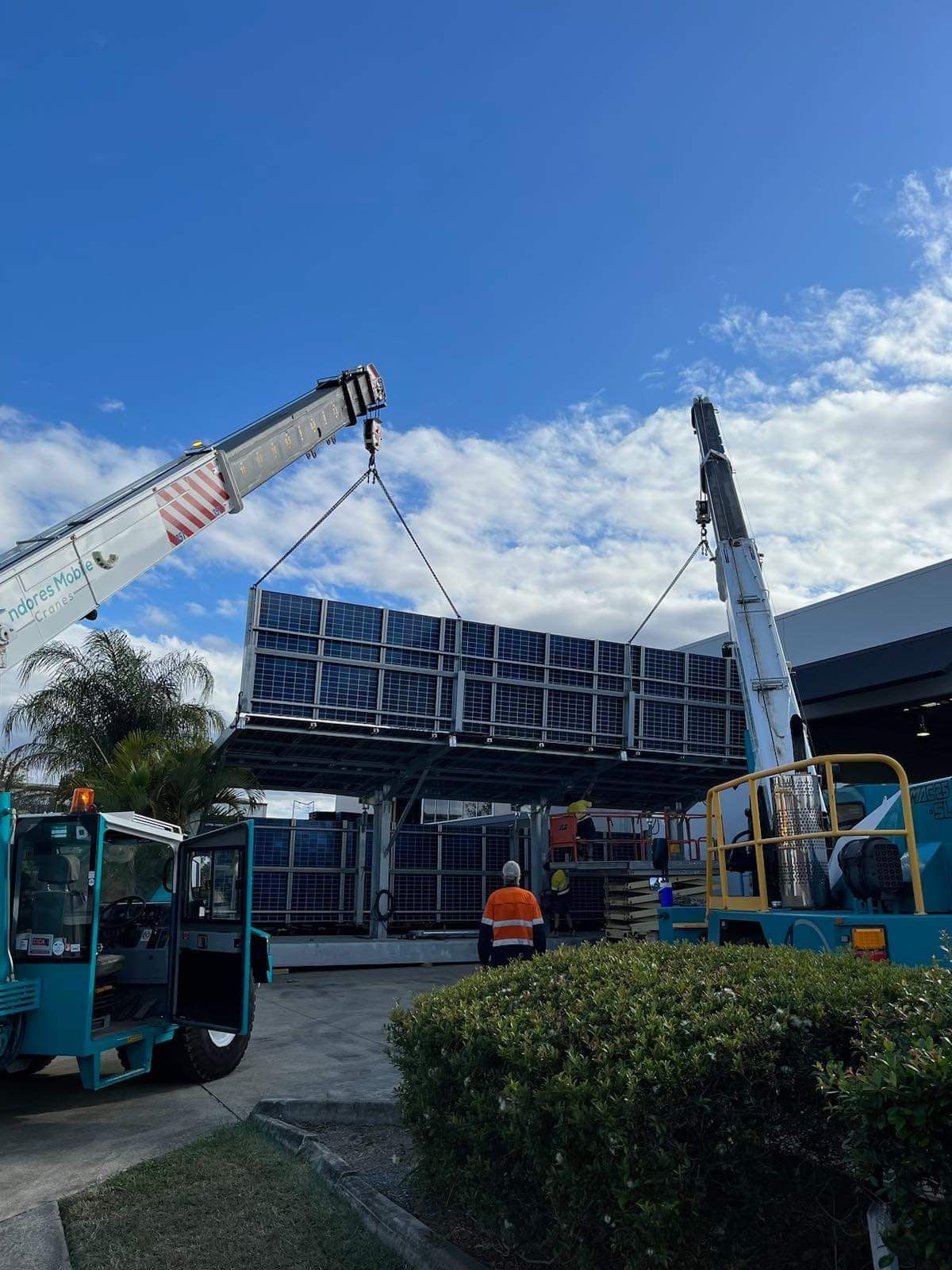Rising Giants: Exploring the History of Mini Crawler Cranes

Mini Crawlers are the small but mighty machines that have become the backbone of construction projects all over the world. Mini crawler cranes are powerful and versatile tools that are not be underestimated. The name, Mini Crawler, has emerged as a household name in the crane industry, renowned for its ability to squeeze into tight spaces, and lift items in places otherwise unreachable with traditional cranes.
Lindores Mobile Cranes have 2.8T, 4.5T or 4.8T Mini Crawlers available to hire. Enjoy the convenience of the Mini Crawler’s manoeuvrability and choose the lifting capacity best suited to your project.
But how did we get here? Join us on a journey through time as we look back at the history and significance of these compact giants.
Birth of Mini Crawler Cranes
The concept of mini crawler cranes came about as a response to the need for compact yet robust lifting solutions in constrained spaces. Whether navigating through urban landscapes or working within confined industrial sites, these cranes were designed to provide a lifting solution that combines strength with agility.
Evolution of Technology
Mini crawler cranes have not only become smaller in size but also smarter in technology. Over the years, advancements such as remote control operation, precision controls, and enhanced safety features have been integrated into the design. This marriage of strength and brains has made mini crawler cranes vital in scenarios where precision and efficiency are paramount.
Applications Across Industries
Mini Crawler cranes’ adaptability is what sets them apart from the rest. From construction sites to maintenance projects in industrial facilities, these cranes have found a myriad of applications. Their ability to access tight spaces and navigate challenging terrains has made them a preferred choice for tasks that might be too tricky for traditional cranes.
Global Impact
As construction practices evolved globally, so did the demand for mini crawler cranes. The brand's commitment to quality and innovation has not only solidified its place in its country of origin, Japan, but has also led to international recognition. Mini Crawler cranes are now a staple on construction sites worldwide, contributing to the efficiency and success of a diverse range of projects.
Challenges and Triumphs
The journey of Mini Crawler cranes has not been without its challenges. Economic shifts, technological disruptions, and changing industry standards have all played a role. Yet, the brand's ability to adapt and innovate has allowed it to navigate these challenges and emerge stronger, continually pushing the boundaries of what mini crawler cranes can achieve.
Future Horizons
As we look to the future, Mini Crawler cranes continue to evolve. With an emphasis on sustainability, efficiency, and safety, the brand remains at the forefront of the mini crawler crane industry. As construction methodologies advance, so too will the role of these compact giants in shaping the skylines of tomorrow.
In conclusion, the history of Mini Crawler cranes is a story of ingenuity, adaptability, and innovation. From their humble beginnings to becoming indispensable assets on construction sites globally, these mini crawler cranes are a testament to the ongoing evolution of heavy machinery. They may be small, but they seriously have some muscle!
To hire a Mini Crawler for your next project, head to Lindores Mobile Cranes and book your hire now!
The Liftout

By JADE LINDORES
•
10 May, 2024
Can you imagine trying to undertake a commercial or residential project without a crane? That sounds like our biggest nightmare! Today, we’re taking a look back at how this crane story all started. The use of cranes in Australia continues to evolve, as our construction technology improves, and urban areas expand. Early history In the late 1800s, cranes were essential for handling cargo in Australia's bustling ports and harbors. These robust machines facilitated the loading and unloading of goods from ships, enabling efficient trade and commerce across the continent. From wool and grain to minerals and manufactured goods, cranes played a vital role in the transportation and distribution of Australia's diverse exports and imports, supporting the growth of its economy and international trade networks. In the 19th century, cranes dominated skylines as they facilitated the erection of towering buildings and bridges, emblematic of urban growth and modernization in Sydney and Melbourne. Moreover, in remote regions, cranes played a crucial role in the development of mining operations, aiding in the extraction and transportation of valuable resources such as coal, gold, and iron ore. Post-World War II expansion From the 1940s to 1960s, Australia saw a construction boom after World War II. This led to the increased usage of cranes in both commercial and residential projects. This period marked the increase of high-rise construction in major cities. Technological advancements and the rise of Lindores Mobile Cranes From the 1970s onwards, the introduction of tower cranes revolutionised the construction industry in Australia. These cranes were essential for constructing taller buildings, particularly in the confined spaces of developing CBD’s. In 1985, Lindores Cranes and Rigging was founded by Peter Lindores and started trading as Total Rigging. In 1993, Chris Austin pioneered the introduction of Mini and Mobile Cranes to Southeast Queensland, with his company Mini Cranes Queensland. Recent developments From the 2000s onwards there has been significant advancements in crane technology, including the more-widespread adoption of Mobile and Crawler cranes that offer versatility and efficiency. In 2007, Mini Cranes Queensland was passed on to the Lindores family. We officially changed the name of Queensland Mini Cranes to Lindores Mobile Cranes in 2015. Throughout this time, Lindores Mobile Cranes has continued advocacy of the use of Mobile cranes in construction, industry, and manufacturing throughout Queensland. The future The current trend in the crane industry includes integrating digital technologies for better load management, real-time monitoring, and predictive maintenance. Automation and remote operation of cranes are becoming more prevalent, aiming to increase safety and efficiency. To get Lindores Mobile Cranes on your next job, give us a call on 📞 07 3376 0611.

By JADE LINDORES
•
14 Apr, 2024
Gaining rooftop access can be a critical aspect of construction and maintenance, particularly in urban environments. Cranes, with their lifting capabilities and reach, offer a viable solution for transporting materials, equipment, and personnel to rooftops. While the process of using a crane for these operations can be complex, Lindores Mobiles Cranes has you covered. We take control of the careful planning, coordination, and adherence to safety protocols, in order to efficiently access any rooftop using our range of suitable cranes. In this blog post we will explore the considerations, safety measures, and steps involved in accessing a rooftop using a crane. Understanding the need for crane access Accessing a rooftop using a crane is typically required in scenarios for construction and renovation, where heavy materials and prefabricated structures need lifting. As well as this, cranes can be used for maintenance and repairs, to transport tools and equipment for the job. If you’re unsure what equipment is needed for your rooftop job, contact us! Choosing the right crane It is important to pick the appropriate crane for successful rooftop access. When choosing, aspects such as lifting capacity, reach and mobility need to be considered. Our impressive fleet at Lindores Mobile Cranes can tackle just about anything, so it is important to us to give our customers the right crane for the job. Pre-operation planning A thorough plan is essential for a safe and efficient operation. A site assessment should be done to evaluate the site’s obstacles, ground conditions and space for our crane setup. When Lindores Mobile Cranes are on-site, a lift plan is conducted before use to ensure our crane is efficiently and safely completing the required rooftop operation. Safety measures Using a crane for rooftop access can be a dangerous task if the correct safety measures are not in place. Luckily for you, safety is the backbone of our operations here at Lindores Mobile Cranes. When hiring one of our many cranes, we ensure a qualified crane operator is on-site to complete your task. We implement stringent safety protocols so that all jobs, including rooftops, are conducted carefully and efficiently. If you are need a hand accessing a rooftop, or any other hard-to-reach spot, contact Lindores Mobile Cranes on (07) 3376 0611.

By JADE LINDORES
•
15 Mar, 2024
What do towering skyscrapers, expensive bridges and intricate infrastructure projects all have in common? In their construction, they all relied on cranes. Cranes are the unsung heroes of some of the biggest constructions projects, essential in facilitating progress, efficiency, and safety on-site. Lindores Mobile Cranes have supplied cranes to the commercial industry for decades. Today, we look in greater detail at the indispensable role of cranes in the commercial construction industry. Efficiency and Precision: Imagine trying to build a skyscraper without the aid of cranes – an unthinkable feat! Cranes are synonymous with efficiency, enabling construction teams to hoist heavy materials, manoeuvre them into precise positions, and orchestrate seamless assembly processes. Lindores Mobile Cranes, with their advanced technology and skilled operators, exemplify efficiency in action. Whether it's lifting steel beams, positioning pre-cast concrete panels, or installing mechanical components, their fleet of cranes ensures that every task is executed with precision and timeliness. Versatility and Adaptability: One of the most remarkable features of cranes is their versatility. From towering high-rise constructions to intricate infrastructure projects, cranes come in various types and sizes to suit the specific needs of each endeavour. Lindores Mobile Cranes offers a diverse range of crane solutions, with lifting capacities ranging from 2.8T to 100T. This versatility allows construction companies to tackle a wide array of projects with confidence, knowing they have the right equipment at their disposal. Safety First: Safety is paramount in the construction industry, and cranes play a crucial role in upholding these standards. With their robust design, sophisticated safety features, and experienced operators, cranes ensure that heavy lifting operations are conducted with utmost caution and adherence to protocols. Lindores Mobile Cranes prioritizes safety above all else, implementing rigorous safety measures and providing comprehensive training to their operators to mitigate risks and ensure incident-free operations. Maximizing Productivity: In the fast-paced world of commercial construction, time is of the essence. Delays can be costly and disruptive, impacting timelines and budgets. Cranes, with their ability to streamline construction processes and overcome logistical challenges, are instrumental in maximizing productivity on-site. Lindores Mobile Cranes understands the importance of efficiency and productivity, offering reliable crane services that keep projects on track and on schedule. In conclusion, the role of cranes in commercial construction cannot be overstated. From enhancing efficiency and productivity to ensuring safety and driving innovation, cranes are the backbone of modern construction projects. Lindores Mobile Cranes , with their commitment to excellence and dedication to customer satisfaction, exemplify the vital role that cranes play in shaping our built environment. As construction projects continue to push the boundaries of possibility, one thing remains certain – cranes will always be at the forefront, lifting the industry to new heights. To enquire about having Lindores Mobile Cranes on your next job, give us a call on (07) 3376 0611.
ADDRESS
17 Westcombe Street
Darra QLD 4076
